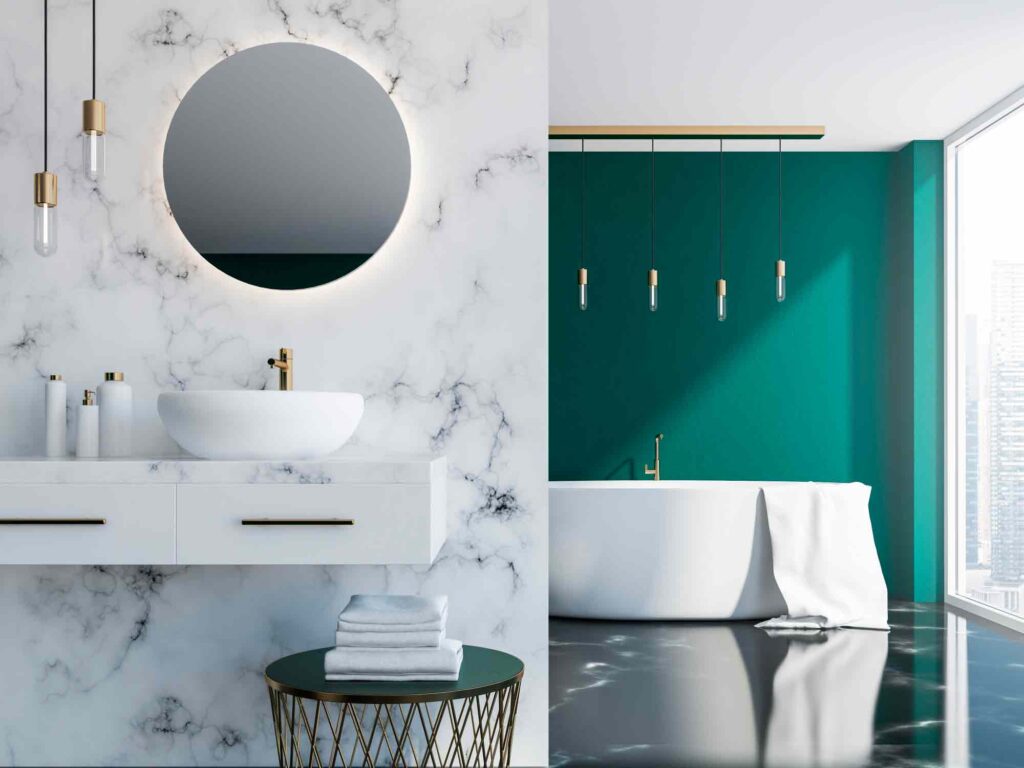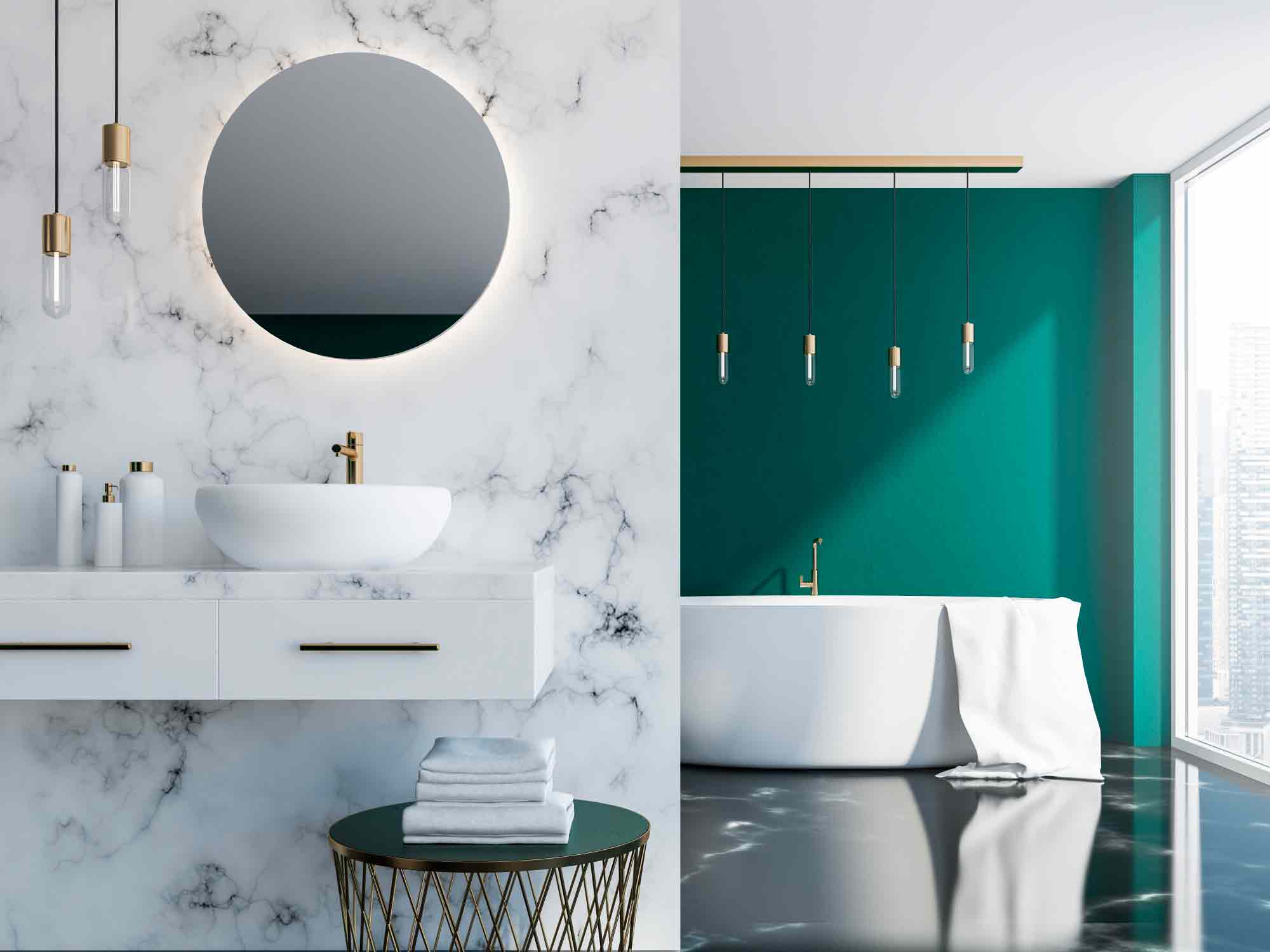The use of natural materials for interior home design projects is at an all-time high this year. Working with marble can be a satisfying and rewarding experience, but it takes knowing your way around different types of marble to ensure you get the desired results. Marble is most commonly used for decorative finishes, as well as in tile installations, so understanding the key characteristics of each type is important for ensuring a successful installation and adding a high-end look to any room or space.


This comprehensive guide will discuss the five main categories of marble and what sets them apart in terms of hardness level, visual look, and cost considerations. Then, we’ll explore some tips on how to install and work with marble properly. By the end, you’ll be able to choose from various marble options and know which tools you need to work with each style.
Types of Marble
Marble comes in various types, and each type’s unique properties can bring something special to your tiling project. Some types feature captivating veining that can lend a classic touch to a space, while others are more subtle but no less attractive.
How it looks depends largely on the angle of light that hits its surface, so there’s always something new to discover regarding types of marble.
For example, Carrara is known for its glossy veins running across the stone and may be ideal for modern spaces since its luster lasts longer than other types. Meanwhile, Calacatta offers dramatic contrast between the white base color and heavy dark veining, giving off a rustic feel that may be perfect for an outdoor space.
These various types of marble have their unique characteristics, so choosing one that meets your aesthetic preferences and all the functional requirements for your project is important. Here is a brief breakdown of today’s five main types of marble on the market.
Carrara
Carrara marble is one of the most popular types of marble for home use, and once you look at it, it’s easy to see why! This elegant marble comes in different beautiful varieties: some with a classic white background and gray veining, as well as blue-gray hues with soft, feathery veining.
Depending on your chosen piece of marble tile, Carrara can add subtle elegance or bold drama to any space. Plus, its durability allows Carrara to stand up against anything life throws at it. Talk about a win-win. It also helps that several famous statues are made out of Carrara marble, including the iconic David statue from Michelangelo.
Statuary
Statuary marble is a classic marble option with unique and interesting features that will make any standard project stand out. You’ll notice this type of marble usually has a uniform background color of light gray. This makes the deep, rich, striking veins stand out even more.
Its polished and shiny surface adds sophistication and timelessness that you won’t find in other materials. Overall, its elegance makes Statuary marble a popular choice for many people today. The dramatic veining of Statuary marble can create breathtaking interior designs that look like works of art.
Calacatta
Are you looking for something super rare? Check out Calacatta marble. It’s so rare that it sells for $420 per square foot. Simply put, Calacatta marble is one of the world’s most esteemed types of marble for its rarity and opulence.
It’s similar to Carrara marble as it’s quarried from the same area in Italy. However, Calacatta marble has some distinct features. The main one is its dark, thick veining that differentiates it from Carrara. Calacatta marble is also famous for being featured in numerous pristine buildings around the globe, like homes, palaces, and monuments, adorning these wonders with a prestigious air.
Emperador
As the name suggests, this type of marble hails from Spain. It’s perfect for adding both classic and modern vibes to your home. Why is it so popular? This luxury marble comes in various colors, from light tans to deep browns.
Emperador marble has a dark hue that helps create a warm atmosphere in any room it’s placed in, making it the ideal choice for indoor areas like fireplaces or cozy nooks.
Crema Marfil
Finally, we have another type of Spanish marble called Crema Marfil. Crema Marfil marble is renowned for its beauty and rustic aesthetic. It has a light beige tone that ranges from creamy to yellowish shades, making it ideal for home flooring.
Interior designers and contractors love Crema Marfil marble because of its versatile nature and ability to turn any room into an elegant retreat. This highly sought-after stone has graced historic homes and modern dwellings alike, making Crema Marfil marble a timeless classic.

What’s the Best Marble?
Based on the different marble designs above, what’s the best marble to use when renovating or building a home? The best type of marble to use depends on the project and budget.
Carrara marble is a great choice for its classic white-grey veining, while Calcutta Gold offers warm matte tones with beautiful golden highlights. Statuary marble has bolder black and white veining that adds an eye-catching contrast, while Emperador Dark offers a deep brown hue for a more subtle look.
All of these marbles offer superior resistance to scratches due to their hardness, yet they are still easy to cut and shape when needed in your project. However, we suggest scrolling down to browse our tips for working with marble before making your final decision.
Different Marble Styles
As you might have noticed above, each one of the marble options mentioned has sub-types or styles. For example, you can choose Emperador marble, or you can choose Emperador Dark marble. This increases your choices, and while that’s great, it can make it more confusing to choose the right one for your project.
To provide guidance, here is a brief breakdown of different marble styles. These are more color suggestions than style guides, so use this to help determine what kind of marble to start with.
White Marble
White marble is a great option for those looking for a sophisticated look without frills. It can quickly turn an ordinary space into something sleek and stylish. Many business owners choose white marble because of its white color, timelessness, and elegance, which helps set the tone of their establishment.
Furthermore, white marble is known to be expensive, but it has superior sturdiness. This usually means it can stand the test of time (yep, even in high foot-traffic areas). Plus, if anybody damages or etches white marble, it can help hide any natural wear and tear that would normally show on other surfaces over time.

Black Marble
Looking for something more versatile? Try black marble. It’s close enough to white marble in terms of elegance, but the black color gives it an entirely different feel. Adding light veins throughout can make your space stand out, forming beautiful and elaborate designs that catch anyone’s eye.
The best part is that black marble is versatile and can be used in various styles. Use it in rooms with a style training from minimalism to industrial and everything in between.
Cream Marble
Opt for cream marble if you don’t want something too dark or too light. With cream marble, you get the best of both worlds. Not only is it a visually stunning piece of stone that can elevate any décor but it’s also incredibly practical.
This type of marble offers incredible versatility and an easy combination with other construction materials. You can customize cream marble to your style and needs by experimenting with different treatments and finishes. So whatever kind of interior design you have in mind, cream marble is sure to make it pop.
Tips for Working with Marble
Working with marble can be intimidating, but stick to the basics of using the right tools, and you’ll succeed. We always suggest testing the marble before making a large order so you can test the quality, hardness, and overall aesthetic in the space before using it.
As for what tools to use, manual tile cutters make straight cuts for tiles of thin to medium thickness (not exceeding 2cm of thickness), whereas wet saws work best when working with thicker tiles. Angle grinders with a diamond blade work well if you need a specific shape that cannot be made with a tile cutter. Either way, choosing the right tool is key to working ahead with confidence.
This includes using tile spacers and leveling systems when laying marble tiles. They ensure that the tiles remain evenly spaced and aligned, enabling you to get a professional-looking finish. Spacing between the tiles should be uniform, horizontally and vertically, to avoid unsightly gaps and wonky lines.
Design with Rubi
Understanding the types of marble available helps as you begin any home renovation project or work as a professional tile installer. However, choosing the right type of marble is only the first step. As mentioned above, you need to consider what tools to use to help you finish the job quickly and efficiently.
Lucky for you, we’ve got you covered. Read through all of our tips and tricks to help you learn how to choose the best tools and use them. Why should you trust us? We’re the leading equipment and tools manufacturer for laying tiles and construction in Europe.



Post a comment